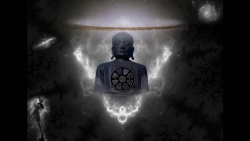The Form Collection
The Vajra family involves our bodies and the Form Collection or Skanda in Sanskrit. The Form Skanda is concerned with connecting and organizing.
So the Vajra family involves our Forms and our discursive thoughts. It involves the details and intricacies of our world. Most of our lives we spend preoccupied with this level and the level of feelings (which is part of the Ratna family). This is due to the fact that there is a tremendous amount of vividness, detail, solidity and structure in every type of Form that surrounds us.
Form helps to provide an anchor and stability to our mind. Mind and Body are often equated to a lame person being carried by a blind man. Without the lame person's eyes and awareness, they would be lost and without the blind person's legs and strength, they would not be able to act on their wishes and go somewhere.
The realm of Form involves all of our senses and their objects. This is part of the reason why they occupy so much of our attention. Objects of sight alone are so many and varied and intricate that they can easily distract us from our goals. There are so many pleasant sights, sounds, smells, tastes and touches that we can spend all of our lives just sampling the many pleasures of the senses.
The pleasures of the senses are so addictive that, even if our lives have a great deal of misery, we can still spend most of our time just chasing the pleasures of the senses themselves. The pleasures can be so wonderful that we will spend all sorts of time and energy chasing after just the promise of pleasure. We may not even attain the pleasure that we are hoping for, but we continue to pursue the sense object anyways because of our experience with other pleasures of the senses and because of their addictive nature.
The intricacies of Forms also help to distract us from many other things. It is possible to delve further and further into the details of even a single outside Form. This can be seen by scientists who spend an entire lifetime investigating one insect for example to the exclusion of everything else. The further we delve into these details and the more focused we become on them, and the farther away we get from a more all encompassing view of the world around us. We can get so caught up in a single form that we can miss entire aspects of the world around us. We can even ignore the possibility that other Forms exist at all or that they could be helpful to us.
If we get preoccupied with Vajra energy, it can turn into extreme Materialism. The focus becomes on Matter and external Objects. There is an emphasis on Form instead of Substance. External appearance becomes more important than internal qualities. The focus is on differences and uniqueness and can lead to emphasis on the individual instead of the group. It can lead to racism, cliquishness and other forms of divisiveness.
Vajra energy is cold, hard, strict, unemotional, and clinical. The season associated with Vajra energy is Winter, icy cold and frozen and hard. Over-emphasis on vajra energy can lead us into a cold, mechanical, unemotional, uncaring world focussed only on Materialism, Individualism and Externals. Sound familiar?
When we grasp at or are carried away by thoughts and forms, they take on a un-proportionately large place in our life and mind. The result is that we lose perspective and no longer see thoughts and forms in relation to other parts of ourselves or the thoughts and forms of others.
Our own thoughts and acquired forms become extremely important to us. The result is that we can tend to defend our thoughts and forms against perceived loss or threats and we tend to feel superior in our own thoughts and forms and very critical of the thoughts and forms of others.
Being carried away by forms and logic, we lose our connection to the other energies that make us up. We can have difficulty with warmth, emotionality, support, or relationship. Our actions can be unskillful because we are missing whole portions of reality that are beyond form or are more subtle than form.
At the same time, form provides us with stability. It provides an anchor for the mind and helps us to control it or slow it down enough to direct it more skillfully. It helps to provide reference points so that we can proceed from A to B to C. Form helps us by giving us examples of cause and effect.
Form also provides us with feedback on how well our mind works and how much we understand the world around us. We may have a certain idea of how something works, but it's only when we try to make it work externally that we find out whether our theory and reality was the same. It is through experimenting between ideas and form that we get the biggest examples of interdependence.
The main exercise in working with Form has two components. We need to practice to become aware of form by noticing the transitoriness of our relationship with outside forms. Even if the form is more permanent (a building for example), we only see it or relate to it for a temporary period (we drive by the building and keep going, or we go into the building, do our errand, and then leave).
The second step is to notice the various components of any particular form and how these components fit and work together. We pay special attention to the structure and interconnection of Forms. This helps to counteract our notion of the solidity and fixedness of the world around us.

